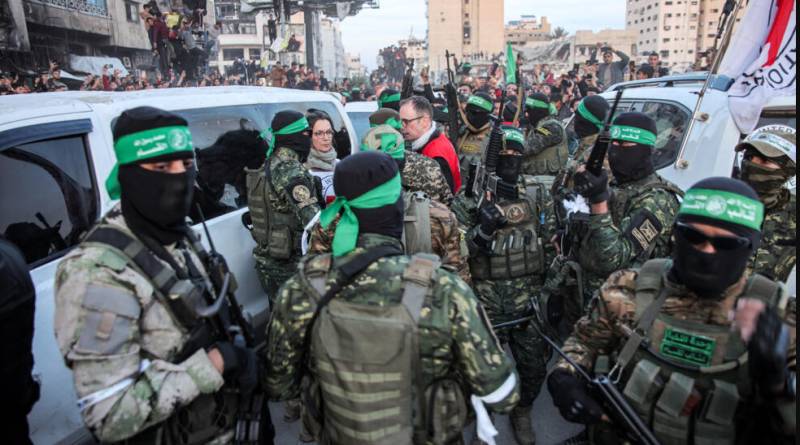Hamas back on Gaza streets after war with Israel

Stay tuned with 24 News HD Android App

After more than a year hiding in tunnels and dodging air strikes, uniformed Hamas fighters returned to the ruined streets of Gaza hours into a ceasefire, defying Israel's vow to crush them.
With the world watching on Sunday as Hamas handed over three Israeli hostages to the Red Cross, dozens of balaclava-wearing fighters in the group's signature green headbands were seen at the packed Gaza City square marshalling the chaotic events.
The day after, Hamas's deputy interior minister for the territory was out and about in Gaza City, declaring that Gazans were "living in a moment of victory".
While Hamas was back on the streets, Israeli forces were withdrawing from the territory's densely populated areas.
The destruction they left behind was staggering, yet Hamas appears to have survived, despite Israel's stated objective from the outset of the war of eradicating the group once and for all.
"When you set yourself complete elimination (as a goal), if one man is standing it can be regarded as a failure," said Yossi Mekelberg, a Middle East expert at Chatham House.
'Fiercest bombardment'
This could prove a problem for Israeli Prime Minister Benjamin Netanyahu, who pledged in the aftermath of Hamas's October 7, 2023 attack on Israel to destroy the group.
"They were under the fiercest bombardment that such an organisation could ever sustain and they are still there and they are still recruiting," Mekelberg said.
Israel decimated Hamas's ranks and killed many of its top leaders, including Ismail Haniyeh and his successor Yahya Sinwar. On Tuesday, Israel's army chief said its campaign had killed "nearly 20,000 Hamas operatives".
Mekelberg cautioned that it was too early to assess Hamas's overall condition, and acknowledged it had suffered heavy losses, but "on your TV, you see that they are still there, with their bandanas and all their masks".
Muhammad Shehada, of the European Council on Foreign Relations, said Israel had specifically targeted civil servants, police and ministers, as part of its efforts to dismantle Hamas's governing ability.
"The continued presence of these officials and forces represents a symbol of defiance, showing they remain operational despite the onslaught," he said.
On Monday, Hamas presented itself as triumphant for having survived, saying in a statement that "Gaza, with its great people and its resilience, will rise again to rebuild what the occupation has destroyed and continue on the path of steadfastness until the occupation is defeated".
'Game of whack-a-mole'
The ceasefire is in its infancy and many questions remain about the future of the Gaza Strip and Hamas.
Michael Horowitz, a Middle East analyst at the security consultancy Le Beck, said Hamas had made a show of strength both to deter rivals within the Palestinian ranks and to show Israel "that any additional rounds of fighting won't lead anywhere".
That Hamas was not defeated was down to "one key reason", he said, namely that Israel "hasn't tried to replace Hamas as a governing entity in Gaza".
Netanyahu has repeatedly insisted that the Ramallah-based Palestinian Authority have no role in the Gaza Strip. This "solely security-focused" vision, said Horowitz, meant "Israel has been stuck in a game of whack-a-mole".
Eva Koulouriotis, an independent Middle East analyst, said Hamas retained "overwhelming popularity" in Gaza, while "attempts... to provide a popular base for the Palestinian Authority and to reject Hamas's rule have failed".
The destruction brought by the war did breed resentment towards Hamas among Gazans, said Shehada, but many were conflicted.
People "also feel a sense of pride" that Hamas's armed wing, the Ezzedine al-Qassam Brigades, defied Israel's might, he noted.
"It revolves around the fact that people have been humiliated... And then it brings a source of pride".
The humanitarian cost of the war for the people of Gaza has been immense.
The health ministry in the Hamas-run territory has put the death toll at more than 47,100, the majority civilians, figures the UN considers reliable.
That devastation was in retaliation for Hamas's October 7 attack on Israel, which resulted in the deaths of 1,210 people, mostly civilians, according to an AFP tally of official Israeli figures.
Horowitz said the scale of destruction was among the worst of any urban battle in recent memory, adding it eclipsed the damage done to Mosul in Iraq during the campaign to dislodge the Islamic State group.
But ultimately, said Mekelberg, Israel's military campaign didn't "deal with the root causes of the conflict", echoing a call by UN chief Antonio Guterres for the ceasefire to be a "first step" towards a long-term political settlement between Israel and the Palestinians.
Only in that way, Mekelberg said, can Israel "create space between (Hamas) and the rest of the (Palestinian) people".
